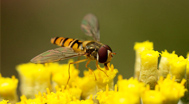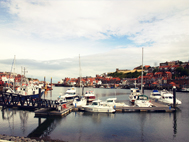| |
May Newsletter
from Contours Walking Holidays

Welcome to the May edition of our newsletter, which is as usual full to the brim with interesting articles and news from across the walking world.
As the weather continues to improve and summer creeps ever closer, we know that many of you will be getting ready to venture out onto the trails, so we want to make sure that you are raring to go by providing a collection of engaging information, anecdotes and advice to inspire you to blow away the cobwebs in the Great British Countryside.
In this month's newsletter we explore the world-wide outdoor hobby known as Geocaching, and Cumbrian Rambler Beth Pipe returns with another fantastic blog article, this time about her adventures around Haweswater in the Lake District. We have also thrown in some interesting facts about cardinal points and which bee-like insects are likely to sting, ensuring you are well prepared for your walking adventures this summer!

Join the World’s Largest Treasure Hunt
By Melody Evans
I joined Contours in December 2015 as a Marketing Assistant, and I have since settled very well into the team. One of the biggest perks of my role – aside from the people, the tuck shop and the office dogs – is that I get to scope out the latest news and trends that are relevant to walking, outdoor pursuits and nature in general, and either highlight them across our social media, website and blog, or bring them to the attention of the team if it’s something we can use to help improve our service.

Recently, I was going about my news-hunting when I stumbled across an activity called Geocaching. For those who, like me, haven’t heard of this before, Geocaching is basically like a world-wide treasure hunt; millions of containers or ‘caches’ have been hidden in various rural and urban locations across the globe, each containing a little logbook for successful finders to write in their names as proof of their find.

These caches come in various shapes and sizes, from tiny little canisters that only hold a sheet of paper, to large military ammunition boxes that are also used for finders to trade little trinkets as a memento of the occasion. For people who love walking and being outdoors in general, Geocaching could well offer a sense of excitement and discovery that many may only remember feeling as kids.
Continue reading ...
Do you have an idea, article or account of your walk that you would like to share? Send an email to newsletter@contours.co.uk to contribute to our newsletter.
Lessons from Haweswater
By Beth Pipe
The Coast to Coast route is such a challenge that it’s tempting to plough on through in order to get the job done, but there are some wonderfully interesting places to pause at along the way, like Haweswater for example. It’s one of our favourite spots to visit in the Lake District, and over the years we’ve been lucky enough to learn more about it and enjoy some wonderful experiences there.

On one of the first occasions we visited we underestimated the Cumbrian weather. We set out with the intention of walking a lap of the lake (technically a reservoir but more on that later); the sun was blazing down from a clear blue sky and, as we weren’t planning on going up high, we left the waterproofs in the car. It’s a well known fact that the best way to ensure a clear dry walk is to take all your waterproofs with you, and the quickest way to guarantee rain is to leave them behind. We only got as far as Riggindale Valley before the heavens opened, and half an hour later we were back at the car dripping wet and trying to wring out what we could so we didn’t get the seats soggy on the way home.

On another occasion we visited during a drought and were lucky enough to walk along some of the old streets of Mardale Green, as the water levels had dropped well below normal. The valley was flooded in 1935 to create the reservoir and the people of Mardale Green were moved away – this wonderful but very brief video from British Pathè News gives a tiny glimpse of the last service to be held in the church. If you have time, be sure to take a visit to Burnbanks, the “temporary” village built to house the workers who built the dam.
Continue reading ...
What are Cardinal Points?
Rather than a rating system by which members of the Catholic clergy are promoted, in our world cardinal points (or cardinal directions) refer to points on the compass. In this context, the alternative definition of ‘cardinal’ meaning ‘fundamentally important’ is being used, and refers to the main or principal points of the compass: north, east, south and west.

Between the cardinal directions are four ‘primary intercardinal points’: north-east, south-east, south-west and north-west, and between the cardinal points and the primary intercardinal points are the eight ‘secondary intercardinal points’: north-north-east, east-north-east, east-south-east, south-south-east, south-south-west, west-south-west, west-north-west and north-north-west.

The mnemonic ‘Never Eat Shredded Wheat’ is often used for remembering the cardinal points in a clockwise direction. Those of a younger generation may prefer ‘Nice Ed Sheeran Wig’. Whatever you use, knowing the cardinal points and being able to remember the order they go in makes navigating significantly easier.
Featured Posts
Fifteen Fabulous Cumbrian Walks by Beth Pipe

When you think about walking in Cumbria naturally the Lake District leaps to mind, but here are fifteen fabulous Cumbrian walks ideas for walks to suit all ages, abilities and adventure levels; so book your hols, grab your boots and head for the great outdoors!
Read more...
The West Highland Way with Contours

Staff at Contours are always heading out on our own walking holidays. This month, our Customer Service Advisor, Christine, set out on the famous West Highland Way.
Read more...
Previous Newsletter

In last month's newsletter, we spoke to one of our most loyal customers about his Contours Walking Holiday experiences, and our regular writer Damian Hall offered his reviews of daypacks to help you choose a backpack for your next adventure. As well as this, we also had plenty of news and exciting developments to share with you, both across the country and within our office, ideal to get you prepared, inspired and ready for walking!
Read more...
| |
National Walking Month
The month of May is officially recognised as the UK’s National Walking Month, which aims to encourage everyone to spend more time outdoors walking for both pleasure and fitness..

While we know that many of our readers are already passionate walkers, this is a great opportunity to encourage friends and family to join in and enjoy the benefits of walking, even if it’s for just a few minutes each day around your local area. It is widely accepted that walking is a fantastic form of low-impact exercise suitable for people of all ages and fitness levels, and as the weather continues to transform into summer, now is the perfect time to get walking!
If you need a little bit of help or motivation to get walking this May, the UK charity Living Streets has a range of tips and campaigns available for you to take advantage of.
Click here to find out more.
Did you Know?
Which striped insects sting and which don't? Here is a handy guide to distinguish between the stingers and the harmless:
WASP (YES)

© Dzipi
The abdomen of the wasp has rings of sharp yellow and black, and it can sting more than once. The venom in wasps contains a pheromone that causes other wasps to become more aggressive, so try not to swat one near its nest or other wasps.
WASP BEETLE (NO)

© S. Rae
The wasp beetle has curved rings on its abdomen and it does not sting, but it lives up to its name by mimicking the Common Wasp in both colouration and in its behaviour, by moving in a jerky fashion similar to a wasp's flight. This mimicry keeps it safe from predators, even though it is actually harmless.
HONEY BEE (YES)

© Nagaelle
The honey bee has softer brown and black rings on the abdomen and it can sting, though usually only once because the sting has a barb that pulls (fatally) the bee’s venom sack with it. Honey bees will only sting if they are very frightened however, so it's best to avoid swatting them and instead let them go about their essential foraging.
HOVERFLY (NO)

© Vlastimil Koutecký
Hoverflies do not sting but they often have wasp-like yellow-and-black stripes on the abdomen. Look out for a telltale vertical black stripe down the back of the abdomen.
New Additions to the Contours Office!
This month the Contours staff were very excited by the arrival of four new members to the team, namely a group of pretty little fish which have taken up residence in a tank near reception!

Named after some of our favourite walking trails, Hadrian, Offa, St Cuthbert and Wild Edric are already a big hit with the staff and visitors, and we hope to add further fish to the family in the near future once they are happily settled in their new home!
Last Month's 'Guess Where?'
Congratulations to Paul Gibson for being the first to correctly identify Whitby Harbour as seen on the Cleveland Way. Whitby is a seaside town, port and civil parish in the Borough of Scarborough and English county of North Yorkshire.
 © Neil Turner (click image to zoom) © Neil Turner (click image to zoom)
To be in with a chance of winning a £10 Contours Walking Holiday voucher, why not try this month's 'Guess Where?' below!
Competition Time: 'Guess Where?'
To win this month's competition, can you guess which National Trail this Jubilee Tower is on?
 (click image to zoom) (click image to zoom)
The first correct answer will receive a £10 Contours Walking Holidays gift voucher. Good luck!

|
|